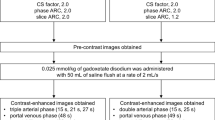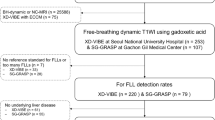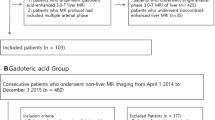Summary
The value of the combined in-phase (IP) and opposed-phase (OP) T1-weighted (T1-W) breath-hold FLASH sequences for hepatic imaging, especially for fat content, was evaluated. Non-contrast-enhanced IP and OP T1-W GRE breath-hold images were obtained in 76 patients refereed for abdominal MRI at 1. 5T. 76 patients were divided into three groups for analysis: (1) liver without mass (n=8); (2) liver with hepatoma (n=34); (3) liver with haemangioma or cyst (n=34). Liver/spleen and liver/lesion signal-to-noise (SNR) and contrast-to-noise ratio (CNR) were assessed for lesion detection. Images between IP and OP sequences were compared quantitatively. The results showed that there was not statistically significant difference in liver/spleen and liver/lesion SNR between IP and OP sequences. In the patients with fatty infiltration, the OP sequences yielded substantially lower values for liver/spleen and liver/lesion SNR than those of the IP sequences. Furthermore, OP imaging showed fatty infiltration in 14 cases and demonstrated hyperintense peritumor rim in 4 cases. In 14 cases of fatty infiltration, many lesions were identified using IP images. The use of IP and OP GRE sequences provides complementary diagnostic information for hepatic lesions and fat content. Focal hepatic lesions may be obscured in the setting of fatty infiltration if only OP sequences are employed. A complete assessment of the liver with MR should include both IP and OP imaging.
Similar content being viewed by others
References
Martin J, Sentis M, Puig Jet al. Comparison of in-phase and opposed-phase GRE and conventional SE MR pulse sequences in T1-weighted imaging of liver lesions. JCAT, 1996, 20(6): 890
Martin J, Catasus X, Puig J. Chemical-shift gradient-echo MR imaging: an accurate method to characterize liver nodules for fat content. Magnetom, 1999, 6(1): 6
Yoshikawa J, Matsui O, Takashima Tet al. Fatty metamorphisis in hepatocellular carcinoma: radiologic feature in 10 cases. AJR, 1988, 151: 717
Freeny P C, Baron R L, Teefey S A. Hepatocellular carcinoma: reduced frequency of typical findings with dynamic contrast-enhanced CT in non-Asian population Radiology, 1992, 182: 143
Stevens W R, Johson C D, Stephens D Het al. CT findings in hepatocellular carcinoma: correlation of tumor characteristics with causative factors, tumor size, and histologic tumor grade. Radiology, 1994, 191: 531
Martin J, Sentis M, Zidan Aet al. Fatty metamorphosis of hepatocellular carcinoma: Detection with chemicalshift gradient-echo MR imaging. Radiology, 1995, 195: 125
Eguchi A, Nakashima D. Okudaira Set al. Adenomatious hyperplasia in the vicinity of small hepatocellular carcinoma. Hepatology, 1992, 15: 843
Mitchell D G, Crovello M, Matteucci Tet al. Benign adrenocortical masses: diagnosis with chemical shift MR imaging. Radiology, 1992, 185: 345
Hooper L D. Mergo P J. Ros P R. Multiple hepatorenal angiomyolipomas: diagnosis with fat suppression, gadolinium-enhanced MRI. Abdom Imag, 1994, 19: 549
Author information
Authors and Affiliations
Rights and permissions
About this article
Cite this article
Haibo, X., Donglin, J., Lian, Y. et al. The value of in-phase and opposed-phase T1-weighted breath-hold FLASH sequences for hepatic imaging. Current Medical Science 20, 290–293 (2000). https://doi.org/10.1007/BF02888182
Received:
Published:
Issue Date:
DOI: https://doi.org/10.1007/BF02888182




